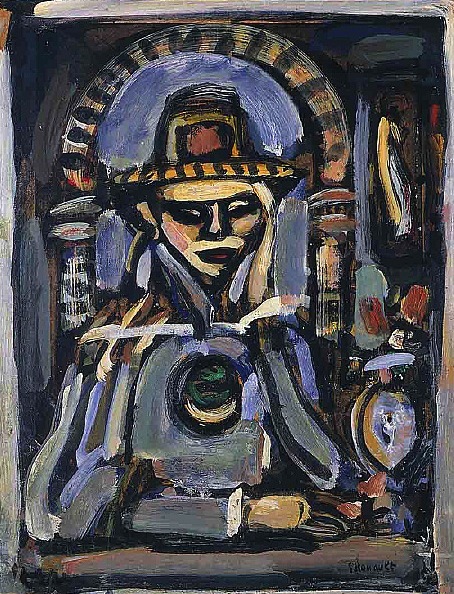With his devout Christianity and dour conservatism, George Rouault did not fit the traditional model of a bohemian Expressionist painter. Early in his career, he made friends with artists like Henri Matisse and André Derain and worked in a Fauvist, or French Expressionist, style, with vibrant colors and broad, slashing brushstrokes. Later, however, he veered away from popular modes of Expressionism and developed into, in the words of art collector and critic James Thrall Soby, a “psychological Expressionist,” in the sense that he tackled not only the personal but rather universal existential issues.[1] It should not come as a surprise, then, that Rouault’s magnum opus was a series of 65 prints entitled “Miserere et Guerre”(“Misery and War”) that he worked on for over twenty years, starting during World War I and creating its final works as the world teetered on the precipice of World War II. As one of the final works of that extended series, he painted “Chinois” or “Chinese,” a dark, brooding portrait of a man sitting in thought. Chinois, painted when Rouault was already a relatively old man (65, though he lived to 87), is reflective of an artist deeply concerned with solemnity, suffering and the divine in a world consumed by modernity and brutal war.
Like other paintings in the series “Miserere et Guerre,” the figure in “Chinois” has black, downcast eyes that are made more prominent by their contrast with the figure’s pale skin. The face is triangular and framed by a high collar. The figure is further framed by the arched doorway or window-frame behind him and by his left hand, which rests on the side of his face. However, his left elbow seems to be suspended above the table, making his pose communicate distress rather than comfort. He wears an identifiably Chinese-style hat whose brim is striped like the window frame behind his head. The objects on his left side are small and plain, in keeping with Rouault’s tendency to de-emphasize the decorative. Nevertheless, the brooding eyes of the figure are what draw in the viewer and communicate Rouault’s narrative of individual suffering. Given the painting’s human scale and vertical orientation, the viewer engages with it on a person-to-person basis, thus emphasizing the empathy for the suffering of the individual (and of Christ) that Rouault emphasized in his work.
Rouault’s choice of the Chinois to communicate suffering during this historical period speaks volumes about his unique approach to primitivism—the modernist technique of emphasizing the noble “simplicity” of non-Western cultures— as well as how he was affected by the sociopolitical turmoil around him. Though the early stages of World War II in Asia had already claimed hundreds of thousands of lives when Rouault painted Chinois (the Nanking Massacre took place from 1937-1938), it is not clear that he meant it to be a specifically topical meditation on geopolitics. In his review of Chinois when it was acquired by the Saint Louis Art Museum in 1960, curator William N. Eisendrath wrote that the artist’s focus on China came from the fact that “the Chinese invented the gunpowder which was being used to destroy so much human life against the tenets of God and Man.”[2] By focusing on a Chinese figure, Rouault placed the responsibility for human suffering as well as the effects of that suffering on the shoulders of one archetypal figure.
Rouault used primitivism to communicate via “the Other” in a way he felt he could not with Western subject matter or figures. This approach differed from other Expressionists like Max Pechstein who represented so-called primitive peoples as a way of reflecting on a pre-modern past. According to art historian Stephen Schloesser, Rouault’s primitivism “attempts a likeness of Christ that is…not representational but presentational, unmediated…It is as though the brutality of the modern world, quickly gathering steam in 1933, forced an representations of divinity—even an incarnate one—into an almost impossible paradox.”[3] The divine was not to be found in Europe, with its decadent and destructive modernity, so Rouault opted for a subject matter that could more capably serve as a medium for Christ-like suffering and sacrifice.
As a deeply religious person, Rouault’s work was strongly informed by the figure of Christ. He believed that Christ exemplified some of the central conflicts of modern life, particularly with regard to poverty and war. Throughout the Great Depression of the 1930s he painted scenes from the life of Jesus to illustrate his feelings about modernity. Rouault also had a tendency to self-identify with Christ, portraying himself in his writings as a self-assured martyr surrounded by threatening forces. He painted Chinois during a particularly trying time personally and professionally, when he felt “trapped—wretched and harassed from all sides…but I am inwardly at peace.”[4] The figure in Chinois, claustrophobically framed by the other elements in the painting, communicates this sense of entrapment and harassment while remaining calm and inwardly focused.
Chinois is a continuation of Rouault’s meditations on suffering that had been the central focus of his work for decades. Unlike some other Expressionists whose work changes notably to reflect Europe and the world’s descent into totalitarianism and war, Rouault took a longer view of human suffering: it was an omnipresent and overpowering reality of existence: “Are we not all slaves?/ There are tears at the very heart of things.”[5] If he offered any recommendation to the viewer, it was to embrace the Christian approach to suffering: a steadfast acceptance of painful realities and the belief in a higher power and salvation.
[1] William N. Eisendrath, “‘The Chinese’ by George Rouault,” Bulletin of the City Art Museum of St. Louis 44, no. 1 (1960): 9-10.
[2] William N. Eisendrath, “‘The Chinese’ by George Rouault,” Bulletin of the City Art Museum of St. Louis 44, no. 1 (1960): 9-10.
[3] Stephen Schloesser, "Mystic Masque, Hieratic Harmony," in Mystic Masque: Semblance and Reality in Georges Rouault 1871-1958, 285-308 (Chicago, IL: University of Chicago Press, 2007), 292.
[4] Schloesser, Mystic Masque, 295.
[5] Schloesser, Mystic Masque, 304.
